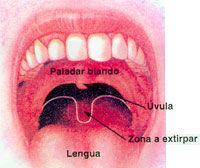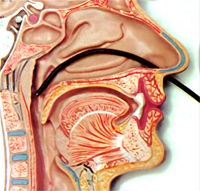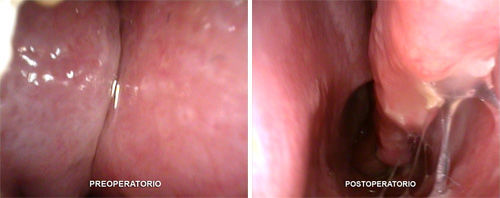Palate diagram


Great hypertrophy of the uvula
Snoring Adult

Snoring due to hypertrophic uvula and palate

Fibroendoscopy
Obstructive Sleep Apnea
Snoring is not only bothersome but can also represent a significant health problem. This is because respiratory pauses (known as sleep apneas) can lead to numerous symptoms, as they cause a cessation of oxygen intake into the body, potentially leading to the so-called “Obstructive Sleep Apnea Syndrome” or OSAS.
What are the symptoms?
- Loud snoring
- Breathing pauses during sleep
- Daytime sleepiness, fatigue, and irritability
- Morning headaches and concentration problems
- Decreased libido or sexual desire
- High blood pressure
Diagnosis
- For a proper diagnosis, a review through a simple examination, the nasal and throat fiber endoscopy, is necessary to determine where the obstruction causing the problem is located.
- In some cases, it is necessary to complete the examination with a sleep study called Polysomnography, which analyzes the intensity of snoring, the number and duration of breathing pauses or sleep apnea, and the quality of sleep.
- Additionally, at the Coromina Center, we perform a pioneering technique called Sleep Videosomnography, which involves a dynamic evaluation of the upper airway during sleep, allowing us to select the most appropriate treatment for the patient.
Treatment
The treatment of sleep apnea or snoring in adults has several approaches depending on criteria established by the ENT specialist after reviewing and examining the patient:
- Laser surgery: Pharyngoplasty. This minimally invasive technique is recommended when the obstruction is due to the closure of the upper airway, that is, the space between the palate, uvula, tonsils, and tongue, due to an excessive size of one or more of these structures. The surgery helps reduce the vibration of the tissue causing snoring and, in turn, decreases the obstruction of the airway responsible for sleep apnea.
- In other cases, it may be necessary for the patient to sleep with a nasal CPAP mask which, by administering a stream of air, prevents the obstruction of the airway.
- Hypoglossal nerve implant: This pioneering technique involves implanting a neurostimulator on the nerve that controls tongue movement during sleep. It is a minimally invasive surgical procedure that offers an alternative for those patients who do not tolerate standard treatment, CPAP (a mask worn at night that delivers pressure to the airway).
- Laser turbinate surgery: This is indicated when the cause of nasal obstruction or blockage is the hypertrophy or exaggerated size of the nasal turbinates. This disproportion of the turbinates causes the patient to have difficulty breathing through the nose.
But what are the nasal turbinates?
Clinical case
Thanks to the endoscopy technique, we can access the inside of the nose and see its entire interior perfectly.
On the left, image of the lower nasal turbinates before the intervention (note the absence of a passage) causing sleep apnea and snoring. On the right, image after the intervention where it can be seen that there is no longer any obstruction and that the space for breathing is much larger.

In the image on the left, we can clearly see a turbinate that has greatly increased in size, leaving virtually no space to breathe, causing obstruction and leading to sleep apnea and snoring.
- There are many techniques to reduce turbinates, for example, Radiofrequency, but in a case like this, where the size is very large, the ideal solution is to reduce the turbinate using a laser.
- Notice, after the surgery (image on the right), the large space that remains is a true “highway” for breathing, and obviously, this reduction is for life. These turbinates will never grow back and the issues of sleep apnea and snoring are permanently resolved.